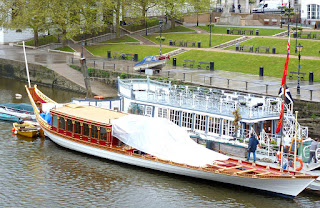A late summer morning was the perfect time for a ramble
along one of the most beautiful sections of the Thames, from Richmond to
Teddington. We started from the station, with its decorative platforms, but
quickly left the busy high street for the historic Richmond Green, once the site of
medieval jousting tournaments and described by Nicholas Pevsner as "one of
the most beautiful urban greens surviving anywhere in England".
It covers
roughly 12 acres, and behind its fringe of majestic trees are period
townhouses and historic buildings, including the Richmond Theatre, which dates from Queen Victoria's reign. The
land between the Green and the river was once the site of a royal palace built
by Henry VII. This superseded an earlier palace, known as Sheen, but the king named it after his North Yorkshire earldom, Richmond. Later it became a favourite retreat for Henry VIII and
then Elizabeth I, who died there.
Little remains of its glory days, apart from this
archway and some brickwork, but with a little imagination you could conjure up
the image of royal barges, resplendent in red and gold, bringing the rulers
from the noise and stink of central London to the rural tranquillity of the
riverside. (In fact, back in 2012, such a barge, the Gloriana, was actually
built in Richmond to celebrate the Queen’s Diamond Jubilee. I was lucky enough to spot her there (below) before
she took part in the river pageant.)
Richmond's popularity with the gentry is
reflected in the many elegant villas that still line this stretch of the river.
As we emerged from the palace grounds and made our way down to the water’s edge
via Old Palace Lane, we had a glimpse of Asgill House, built in Palladian style
as a summer and weekend retreat for Sir Charles Asgill, Lord Mayor of London in
1761 – 62.
The meandering path took us south along the river, passing under the elegant Richmond
Bridge, built in the 1770s to replace the ferry crossing that had been there
for centuries.
Recently I discovered that a distant ancestor, William Hill Sargeant, was one of
the last apprentices to work on that ferry. He was bound in 1766 to William Price
of the Thames Watermen and Lightermen and later captained ships in
the breakaway American colonies, so it must have been good training.
Today
there are several restaurants along this stretch of the river. One, Gaucho, is
sheltered by a huge London Plane tree said to be the largest in the capital and thought
to be more than 200 years old.
The Thames remains a hugely popular area for boating. It's amazing to see how many different kinds of vessels are moored here or just passing through.
At one point we came across the entrance to a tunnel beside the path. Intrigued, we followed it inland and immediately found ourselves among the colourful flower beds of Terrace Gardens (above). The area is a former quarry, but in the 18th
century it became part of bordering estates, and was opened as a public park in
1887. A statue of a river god presides over it.
Overlooking us from
a commanding position on Richmond Hill was the Star and Garter, once a home for
injured servicemen, and now converted into luxury apartments. Further on, we were surprised at how rural the scenery had become, with cattle grazing peacefully on
the Petersham meadows.
At this point, the opposite bank of the river has several notable villas,
the first of which is Marble Hill House built in Palladian style between 1724 and 1729 for
Henrietta Howard, mistress of King George II (below).
Next, hidden by trees, is Orleans
House Gallery, the remaining part of another Palladian villa, which was built
in 1710 but fell into disrepair and was mostly demolished in 1926. Later restoration
work saved the baroque Octagon Room, which now displays many art works that
reflect the area’s history. A third stately home, York House (below), was built in
the 1630s and took its name not from a duke, but from the Yorke family, who
owned farming land in the area. It currently serves as the town hall for Richmond on Thames.
By now we had reached Twickenham, and beside the Thames Path was Eel Pie Island,
once accessible only by boat, but now with a single slender footbridge. It’s
supposedly named after the pastries sold there when eels were plentiful in the
surrounding water. Famous names to have performed in the island’s hotel include
The Rolling Stones, The Who, David Bowie, the Kinks and Pink Floyd.
Continuing along the path, we stopped briefly to admire Teddington Lock (above), which is in
fact a complex of a weir and three locks – big, middle-sized and small, so as to cater for everything from barges to skiffs. It was first constructed in 1810, but later rebuilt and enlarged.
Nearby is the Teddington Obelisk, which marks the Thames’s
usual tidal limit. By now we’d covered around four miles, and were
ready for lunch. We stopped at the riverside pub, The Anglers, and after a
leisurely meal headed home via Teddington High St and the railway station. Our last glimpse of the Thames included, fittingly, an angler enjoying the sunshine.






































